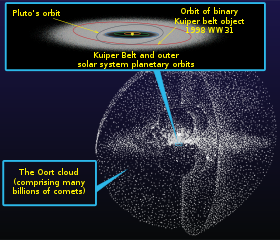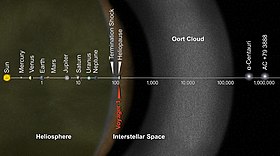Hyperbolic comet
|
|||
|
|||
The following is a list of parabolic and hyperbolic comets in the Solar System. Many of these comets may come from the Oort cloud, or perhaps even have interstellar origin. The Oort Cloud is not gravitationally attracted enough to the Sun to form into a fairly thin disk, like the inner Solar System. Thus comets originating from the Oort Cloud can come from roughly any orientation (inclination to the ecliptic), and many even have a retrograde orbit. By definition, a hyperbolic orbit means that the comet will only travel through the Solar System once, with the Sun acting as a gravitational slingshot, sending the comet hurtling out of the Solar System entirely unless its eccentricity is otherwise changed. Comets orbiting in this way still originate from the Solar System, however. Typically comets in the Oort Cloud are thought to have roughly circular orbits around the Sun, but their orbital velocity is so slow that they may easily be perturbed by passing stars and the galactic tide.
Prior to finding a well-determined orbit for comets, the JPL Small-Body Database and the Minor Planet Center list comet orbits as having an assumed eccentricity of 1.0. In the list below, a number of comets discovered by the SOHO space telescope have eccentricities of exactly 1.0, because most orbits are based on only an observation arc of several hours or minutes. The SOHO satellite observes the corona of the Sun and the area around it, and as a result often observes sungrazing comets, including the Kreutz sungrazers. Although officially given an assumed eccentricity of 1.0, the Kreutz sungrazers have an orbital period of roughly 750 years, and originate from the progenitor of the Great Comet of 1106. Furthermore, many of the Kreutz sungrazers do not survive perihelion, as they are quite literally "sungrazers" – their average perihelion distance is 0.0050 astronomical unit (AU), and the radius of the Sun is 0.0046 AU.
...
Wikipedia


